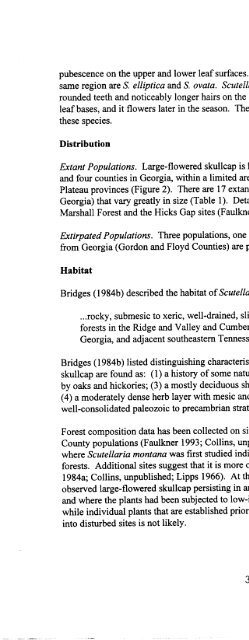Large-flowered Skullcap Recovery Plan - U.S. Fish and Wildlife ...
Large-flowered Skullcap Recovery Plan - U.S. Fish and Wildlife ...
Large-flowered Skullcap Recovery Plan - U.S. Fish and Wildlife ...
You also want an ePaper? Increase the reach of your titles
YUMPU automatically turns print PDFs into web optimized ePapers that Google loves.
pubescence on the upper <strong>and</strong> lower leaf surfaces. Two other skullcaps that can occur in the<br />
same region are S. elliptica <strong>and</strong> S. ovata. Scutellaria elliptica tends to have leaf margins with<br />
rounded teeth <strong>and</strong> noticeably longer hairs on the leaf Scutellaria ovata has strongly cordate<br />
leafbases, <strong>and</strong> it flowers later in the season. The Appendix includes a key used to distinguish<br />
these species.<br />
Distribution<br />
Extant Populations. <strong>Large</strong>-<strong>flowered</strong> skullcap is known to occur in two counties in Tennessee<br />
<strong>and</strong> four counties in Georgia, within a limited area ofthe Ridge <strong>and</strong> Valley <strong>and</strong> Cumberl<strong>and</strong><br />
Plateau provinces (Figure 2). There are 17 extant populations (12 in Tennessee, five in<br />
Georgia) that vary greatly in size (Table 1). Detailed population data is available for the<br />
Marshall Forest <strong>and</strong> the Hicks Gap sites (Faulkner 1993, Kemp 1983).<br />
ExtirpatedPopulations. Three populations, one from Tennessee (Hamilton County) <strong>and</strong> two<br />
from Georgia (Gordon <strong>and</strong> Floyd Counties) are presumed extirpated due to habitat alterations.<br />
Habitat<br />
Bridges (1984b) described the habitat of Scutellaria montana as follows:<br />
.rocky, submesic to xeric, well-drained, slightly acidic slope, ravine <strong>and</strong> stream bottom<br />
forests in the Ridge <strong>and</strong> Valley <strong>and</strong> Cumberl<strong>and</strong> Plateau provinces ofNorthwestern<br />
Georgia, <strong>and</strong> adjacent southeastern Tennessee (<strong>and</strong> probably Alabama).<br />
Bridges (1984b) listed distinguishing characteristics ofthe forests where large-<strong>flowered</strong><br />
skullcap are found as: (1) a history ofsome natural pine occurrence; (2) a canopy dominated<br />
by oaks <strong>and</strong> hickories; (3) a mostly deciduous shrub layer with some evergreen Vaccinium;<br />
(4) a moderately dense herb layer with mesic <strong>and</strong> xeric species; <strong>and</strong> (5) the site occurring on<br />
well-consolidated paleozoic to precambrian strata, often with some exposed rock.<br />
Forest composition data has been collected on sites in the Marshall Forest <strong>and</strong> the Marion<br />
County populations (Faulkner 1993; Collins, unpublished; Lipps 1966). Data from the sites<br />
where Scutellaria montana was first studied indicate that it occurred in late-successional<br />
forests. Additional sites suggest that it is more of a mid- to late-successional species (Bridges<br />
1984a; Collins, unpublished; Lipps 1966). At the Marion County site, Faulkner (1993)<br />
observed large-<strong>flowered</strong> skullcap persisting in an areawhere timbering activities had occurred<br />
<strong>and</strong> where the plants had been subjected to low-intensity ground fires. He concluded that<br />
while individual plants that are established prior to the disturbance may survive, recruitment<br />
into disturbed sites is not likely.<br />
3

















